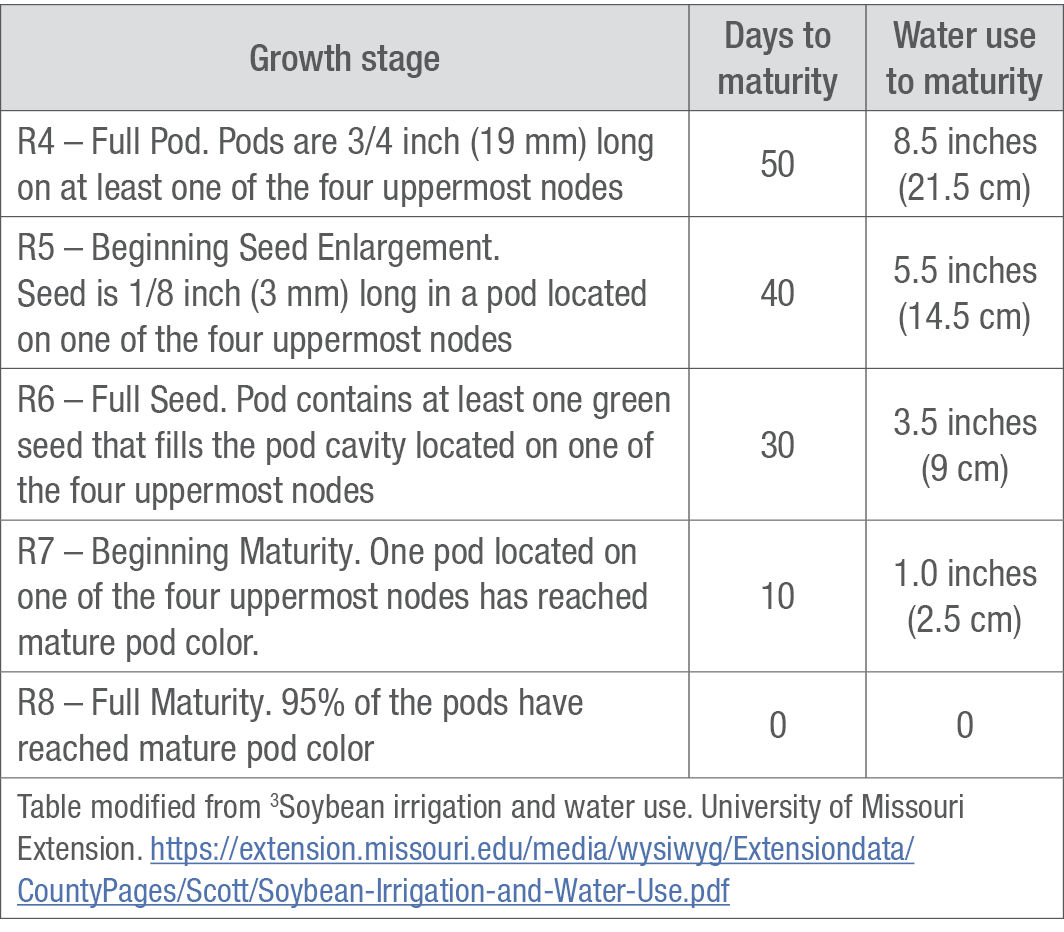5 MIN READ
Irrigation Termination for Soybean
February 14, 2024
- It is especially important to provide adequate water to soybean from growth stages R3 (beginning pod) through R6 (full seed).
- In general, a full soil water profile around the R6 growth stage should be sufficient.
- The coarser the soil texture, the later the final irrigation should occur.
- Closely monitoring soil moisture can help with irrigation scheduling.
Soybean Water Usage
Knowing the optimal time to terminate irrigation can help maximize profitability, as continuing to irrigate longer than needed adds cost with minimal return. However, discontinuing irrigation too soon can result in yield penalties due to decreased seed size. It is especially important to provide adequate water to soybean from growth stages R3 (beginning pod) through R6 (full seed), which are the most sensitive to water stress and potential yield losses.
When to Terminate Irrigation
Methods for determining when to terminate irrigation include testing soil moisture by hand in conjunction with soil moisture sensors (i.e., capacitance probes or tensiometers) or a moisture deficit accounting system. In general, a full soil water profile during the R6 growth stage should be enough to bring the crop through maturity without inducing water stress. If irrigation scheduling is being used to monitor soil moisture, factor in the predicted maturity date of the crop, the estimated water use to maturity (example given in Table 1, may vary by region), and current soil moisture levels to determine when to stop irrigating. Irrigations should provide only what is needed to maintain soil moisture above 50% until the end of R7 growth stage.1 However, it is critical to monitor soil moisture through R7 because conditions that increase water use such as high heat, high winds, and low humidity may require extra irrigation to prevent yield loss. By R8, water is no longer needed for seed enlargement and soil moisture can be allowed to reach 60% depleted.2
Table 1. Example of water requirements for soybean during late reproductive stages through maturity3

Another approach is to determine when pods reach the full seed (R6) growth stage and estimate soil moisture from soil samples. In general, if soil moisture is adequate and 50% or more of the pods have seeds that are fully formed, then irrigation can be terminated. If the soil is beginning to dry, one additional irrigation should be applied to ensure that all seeds reach their maximum weight. If pods are not fully filled and soil is dry, one or more irrigations will be needed to achieve full yield potential. Recommendations on when to terminate irrigation during the R6 growth stage are also dependent on various soil factors. For example, irrigation will be required later in R6 and possibly even into the R7 growth stage on soils with low plant available water holding capacity or when root-restricting layers are present in the soil profile.
Sources
1 Helsel, D.G. and Helsel, Z.R. 1993. Irrigating soybeans. Publication G4420. University of Missouri Extension. https://extension.missouri.edu/publications/g4420
2 Yonts, C.D., Melvin, S.R., and Eisenhauer, D.E. 2008. Predicting the last irrigation of the season. University of Nebraska-Lincoln Extension. NebGuide G1871. https://extensionpublications.unl.edu/assets/html/g1871/build/g1871.htm
3Soybean irrigation and water use. University of Missouri Extension. https://extension.missouri.edu/media/wysiwyg/Extensiondata/CountyPages/Scott/Soybean-Irrigation-and-Water-Use.pdf
Additional Resources
Tacker, P. and Vories, E. Chapter 8: Irrigation. In Arkansas Soybean Production Handbook – MP197. University of Arkansas Cooperative Extension Service. https://www.uaex.uada.edu/publications/MP-197.aspx
1321_59491
Seed Brands & Traits
Crop Protection
Disclaimer
Always read and follow pesticide label directions, insect resistance management requirements (where applicable), and grain marketing and all other stewardship practices.
©2024 Bayer Group. All rights reserved.